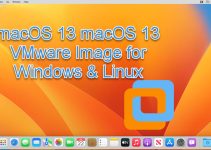Follow these steps to download and install working OS X 10.9 Mavericks pre-installed VMware image for Windows 10, and 7 on Intel processor computers. Doing a fresh installation of OS X 10.9 on VMware workstation by Apple’s original DMG file is not so easy. We already published a guide about installing Mavericks on VMware from the DMG file. Instead of going through those difficult tasks, you can simply download this pre-installed and configured image and use it instantly. Since this was made by the vanilla kernel (without modifying the original kernel), future software updates also possible with it.
Steps to Use OS X 10.9 Mavericks VMware Image on Windows 10/8.1/7
1) Make sure that your physical computer supports hardware virtualization technology ( vt-x). Mostly all the recent desktop and laptop computers support virtualization technology nowadays. In some computers this feature is already activated, in others it should be activated manually in computer BIOS settings.
You can read our earlier guide to find out how to enable hardware virtualization technology ( vt-x) in BIOS and how to test it.
2) Download the Mavericks retail image. Since the owner’s website is not working anymore, you can download it from this link.
3) Extract the main file which is in 7z format. You can use WinRAR or 7z.exe program for this purpose.
4) We need to use an unlocker patch to make VMware workstation to support Mac guest in Windows OS.
If you are using the latest VMware workstations such as 14 or 15, use this link to download the unlocker – how to use VMware unlocker in Windows OS.
Note: Sometimes after using unlocker in VMware workstation, the Apple Mac OS X guest support may not appear. But still, the OS X guest will boot and work fine.

5) Open the vmx file of the retail Mavericks virtual machine as shown below.
6) Before starting the virtual machine, you can modify the settings on the next screen. I have increased the RAM to 2GB and the number of processors to 2.
7) Power on VM now. If VT-X is enabled properly and unlocker worked fine, you could see the initial configuration screen without any issues.
8.) After doing a few configurations, you will land on well working Mavericks virtual machine.
Remember- This is just for testing and learning purposes only. In the virtual environment, you will not get all features of OS X as running it on Apple hardware.
VMware Tools for OS X 10.9 Mavericks on Windows OS
Sound and network work fine in this method without installing VMware tools. It is already having multiple screen resolution options which normally come only after VM tools installation. Also, full-screen mode and auto-adjust screen size did not work after installing tools. Therefore, I do not see any valid reasons for VMware tools on OS X 10.9 except VMware shared folder.
If you need VMware shared folders on Mavericks with Windows 10 or 8.1 or 7 to share Windows OS folders and drives with guest OS, then continue the installation.
9) Mount the (attach to VM’s CD drive) darwin.iso file which is included in the same folder.
10) When the CD drive opens automatically, double click ‘Install VMware Tools’ and begin the installation.
Recommended: Take a snapshot of the virtual machine before beginning the installation. It will be easy to rollback if anything goes wrong in the future.
After restarting, to make sure that VMware tools have been installed properly, go to VM in the menu and see for the below option. If the ‘Reinstall VMware tools’ option is available, that means it’s already installed and working inside the virtual machine.
Configure VMware Shared Folder in OS X 10.9 Mavericks with Windows 10 and 8.1
11) Go to settings of the virtual machine and add a Windows OS host folder/partition. While setting up, you can select ‘Read Only’ if you like to protect the host data.
Remember: VMware shared folder doesn’t require any network connectivity or configuration between host and guest. This purely works with VMware tools and integration services. So, it is very simple to configure and use without network connectivity.
12) Inside Mavericks guest OS, you can access VMware shared folder in Computer as shown below.
Here is a video tutorial guide made by the owner of this OS X 10.9 VMware image.
This build can be upgraded to the latest versions of macOS. Take a backup or snapshot and start upgrading to the latest releases if you really need to have the recent macOS for your learning or development purpose.
Upgrading 10.9 to 10.10 Yosemite in VMware
We used this same pre-installed 10.9 image to update to 10.10 Yosemite and it worked fine. Without downloading any DMG files separately, the Apple App store update worked fine since we used the Vanilla kernel here.
Here is the status of the virtual machine before upgrading. If you notice, we already upgraded 10.9.0 to 10.9.3 which was the minor release from Apple.

As suggested, take a snapshot of VM before starting the upgrade process.
The installation will begin normally.

Select the existing OS disk to over the current version. Click next to continue.

Here is the working 10.10 Yosemite OS which was upgraded from 10.9 on VMware workstation.



















The vmware images work well, but a bit slow, thanks for this new approach to buy a tony Mac, Please make available the OS X Yosemite when available as a vmware machine, thanks